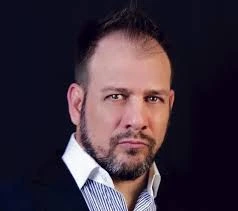1) Can you share a bit about your role and responsibilities as Executive Creative Director, and how does your work contribute to the success of the advertising campaigns across SMEs, Fortune companies, and both B2B and B2C sectors?
My functions are actually divided into two parts: as an executive, I have direct contact with the client, which allows me to avoid losing information along the way, something very common in large agencies where the creative team does not have direct contact and is usually instructed by executives, who in most cases are biased, preventing optimal results.
In my role as creative director, I focus on analyzing the market and creating a strategy to achieve the most optimal results, achieving the objectives of each client by optimizing resources, and maximizing these results to achieve ROI and, in most cases, exceed CAC expectations. Furthermore, I am involved in the entire process, since not being a giant agency allows me to streamline all processes by participating in each step we take directly with my team, coordinating everyone and all rowing in the same direction. When I have to draw, design, or do any other task, I also enjoy it.
2) Art plays a significant role in conveying messages and branding. How do you approach art differently when working with SMEs compared to large corporations like Fortune 500?
Although each new project is a challenge regardless of the size of the company, working with large Fortune 500 clients is quite different since they have already defined brand guidelines, so the creative and artistic process is usually a greater challenge because it’s more limited.
When we work with SMEs, we often start from scratch, giving us more room for creativity, although this also has its share of challenges and responsibilities.
But the truth is that I have always liked challenges. they help me push myself, which drives my professional and personal growth.
3) In advertising, how does the use of visual elements and design differ in B2B campaigns versus B2C campaigns, and what are some unique challenges?
Each channel has its own rules and its own language, and obviously the “buyer persona” is very different, which is why different visual strategies are usually used.
The key challenge at IGNITE Global Marketing is to understand that behind clients there are people, and we must convince them to carry out campaigns aimed at people. Whenever we have achieved it, we have achieved great results, and we have highly successful case studies that support this.
Visually dull materials for B2B campaigns are common. Trying to convince some clients to get out of that spiral is quite complicated. The visuals of B2B campaigns can be very technical, as the buyer persona demands; the USP they want to see is different, but there is no need to make them boring or without visual attraction that invites them to read. That is why focus on going above and beyond in this sense and not forgetting to humanize each campaign, whether B2B or B2C.
In B2C, the challenge is different and changing. The B2C market is absolutely saturated, and attracting the buyer’s attention is increasingly challenging. You have to push yourself and be genuinely creative.
4) Can you provide examples of successful campaigns where the choice of artistic elements had a substantial impact on the campaign’s effectiveness for different types of businesses?
Any successful campaign is due to all the elements that make it up: the creativity, the visuals, the text, and, of course, the creative strategy behind it.
BMW’s B2C campaign of “Do you like to drive?” always comes to mind,. which was an idea by Javer Carro at Barcelona’s SCPF agency. I think the simplest ideas are the most brilliant.
Campaigns of the late Jeff Labbe, whom I had the honor of meeting in person, are my reference; spots that he made for clients like RayBan, Nike, Levi’s, or Adidas are legendary, and haven’t aged a day.
5) When working on through-the-line (TTL) campaigns, how do you balance the use of above-the-line (ATL) and below-the-line (BTL) artistic strategies to create a cohesive brand message?
Something we pay a lot of attention to at IGNITE Global Marketing is precise cost optimization. Depending on the client’s budget and objectives, we analyze the market and design a unique strategy to coordinate all efforts and allow us to achieve the objective without losing coherence in each medium, whether ATL, BTL, or both.
The key is analysis and strategic planning, with attention to every detail, and adapting the message for each medium.
Finally, a good campaign must be adaptable to each medium, without losing its essence, and fulfilling the goal for which it was designed.
6) How do creative strategies help B2B marketers and why marketers must opt for artistic approaches?
Actually, I don’t like calling it an “artistic approach.” Even though the visuals contain artistic elements, I prefer to call it visual creativity since it needs to meet specific objectives and follow certain guidelines set in the creative strategy.
Creativity is essential in communication; it is what allows you to stand out from your
competitors. You are either a leader or a follower. That is the difference between creativity and copying. If we do not use creativity, the message goes unnoticed, and we lose the opportunity to connect with the customer. This obviously turns marketing actions into an expense rather than an investment, since the ROI won’t be there.
7) Could you share your insights on the role of art in storytelling within advertising? How do you ensure that the visual elements complement and strengthen the narrative in your campaigns?
Although I have been writing since I was young, when I started working in advertising, I was an illustrator, and later an art director, so I come more from the visual side. In all my years as an art director, I always worked side by side with copywriters, from whom I learned to develop my skills in ad writing. It helped me a lot to study marketing and understand the background of each action to make a clever point.
I also learned from friends like Javier Sagarna, who gave me a lot of advice when it came to writing, because at that time he was determined to write scripts for films, and I spent hours talking to him.
Nowadays, and in answer to your question, for me, art is essential to telling a story well, so that it’s effective and evokes feelings. So that it connects with the audience, sets the tone of the message, and the viewer perceives exactly what we want them to. Both the visuals and the texts have to be coherent, with the correct typography used, etc. Every detail is important, and I am extremely demanding there.
8) What are the first few factors that you take into consideration when you are targeting different regions and cultures at the same time within the same campaign?
Although we are a small agency, our team is international; we have professionals from Europe, America, and Asia, which allows us to adapt a message to the target we are addressing. It is essential to know each culture. What is normal in one country may be offensive or inappropriate in another.
That is why, when a campaign is going to be carried out internationally, we make sure it suits each region, and also meets objectives.
Of course, when a campaign is carried out like this, it is much more complicated in all aspects. The market analysis is on a different scale, and when it comes to crafting a creative that’s valid in all regions, it’s challenging. But as I told you, I like challenges. The bigger the better. It’s like making a huge puzzle with thousands of pieces.
9) As an industry expert, would you like to share your thoughts for marketers on how to manage creative brains for greater business growth?
It’s simple: the best advice is to make sure you choose the best creative agency, trust them, give them space to be creative, and don’t limit them.
Trust, trust, trust, just as you trust your auto mechanic, plumber, or surgeon.
A company like ours knows how to help each client achieve their goals, and when they let us work without putting obstacles in our way, we achieve the best results.
Visually dull materials for B2B campaigns are common. Trying to convince some clients to get out of that spiral is quite complicated. The visuals of B2B campaigns can be very technical, as the buyer persona demands; the USP they want to see is different, but there is no need to make them boring or without visual attraction that invites them to read. That is why focus on going above and beyond in this sense and not forgetting to humanize each campaign, whether B2B or B2C.
In B2C, the challenge is different and changing. The B2C market is absolutely saturated, and attracting the buyer’s attention is increasingly challenging. You have to push yourself and be genuinely creative.
10) Can you provide examples of successful campaigns where the choice of artistic elements had a substantial impact on the campaign’s effectiveness for different types of businesses?
Any successful campaign is due to all the elements that make it up: the creativity, the visuals, the text, and, of course, the creative strategy behind it.
BMW’s B2C campaign of “Do you like to drive?” always comes to mind,. which was an idea by Javer Carro at Barcelona’s SCPF agency. I think the simplest ideas are the most brilliant.
Campaigns of the late Jeff Labbe, whom I had the honor of meeting in person, are my reference; spots that he made for clients like RayBan, Nike, Levi’s, or Adidas are legendary, and haven’t aged a day.
11) When working on through-the-line (TTL) campaigns, how do you balance the use of above-the-line (ATL) and below-the-line (BTL) artistic strategies to create a cohesive brand message?
Something we pay a lot of attention to at IGNITE Global Marketing is precise cost optimization. Depending on the client’s budget and objectives, we analyze the market and design a unique strategy to coordinate all efforts and allow us to achieve the objective without losing coherence in each medium, whether ATL, BTL, or both.
The key is analysis and strategic planning, with attention to every detail, and adapting the message for each medium.
Finally, a good campaign must be adaptable to each medium, without losing its essence, and fulfilling the goal for which it was designed.
12) How do creative strategies help B2B marketers and why marketers must opt for artistic approaches?
Actually, I don’t like calling it an “artistic approach.” Even though the visuals contain artistic elements, I prefer to call it visual creativity since it needs to meet specific objectives and follow certain guidelines set in the creative strategy.
Creativity is essential in communication; it is what allows you to stand out from your competitors. You are either a leader or a follower. That is the difference between creativity and copying. If we do not use creativity, the message goes unnoticed, and we lose the opportunity to connect with the customer. This obviously turns marketing actions into an expense rather than an investment, since the ROI won’t be there.
13) Could you share your insights on the role of art in storytelling within advertising? How do you ensure that the visual elements complement and strengthen the narrative in your campaigns?
Although I have been writing since I was young, when I started working in advertising, I was an illustrator, and later an art director, so I come more from the visual side. In all my years as an art director, I always worked side by side with copywriters, from whom I learned to develop my skills in ad writing. It helped me a lot to study marketing and understand the background of each action to make a clever point.
I also learned from friends like Javier Sagarna, who gave me a lot of advice when it came to writing, because at that time he was determined to write scripts for films, and I spent hours talking to him.
Nowadays, and in answer to your question, for me, art is essential to telling a story well, so that it’s effective and evokes feelings. So that it connects with the audience, sets the tone of the message, and the viewer perceives exactly what we want them to. Both the visuals and the texts have to be coherent, with the correct typography used, etc. Every detail is important, and I am extremely demanding there.
14) What are the first few factors that you take into consideration when you are targeting different regions and cultures at the same time within the same campaign?
Although we are a small agency, our team is international; we have professionals from Europe, America, and Asia, which allows us to adapt a message to the target we are addressing. It is essential to know each culture. What is normal in one country may be offensive or inappropriate in another.
That is why, when a campaign is going to be carried out internationally, we make sure it suits each region, and also meets objectives.
Of course, when a campaign is carried out like this, it is much more complicated in all aspects. The market analysis is on a different scale, and when it comes to crafting a creative that’s valid in all regions, it’s challenging. But as I told you, I like challenges. The bigger the better. It’s like making a huge puzzle with thousands of pieces.
15) As an industry expert, would you like to share your thoughts for marketers on how to manage creative brains for greater business growth?
It’s simple: the best advice is to make sure you choose the best creative agency, trust them, give them space to be creative, and don’t limit them.
Trust, trust, trust, just as you trust your auto mechanic, plumber, or surgeon.
A company like ours knows how to help each client achieve their goals, and when they let us work without putting obstacles in our way, we achieve the best results.
16) How do you keep your artistic vision fresh and relevant, especially when working with diverse clients across various markets and industries?
I believe my instincts after more than 25 years in the sector are the most relevant when making decisions.
Furthermore, by moving in different media and sectors for different clients in different regions, this always gives me something more to bring to the next project.
My restless nature keeps me fresh. I have to learn something new every day. I study new things daily.
I feed on movies, art, and music. I read a lot on various topics, especially technology. I am always hungry for innovation and new inventions, new tools.
I think the key is to always be open and try to learn from everything around me, with optimism and a builder’s spirit.
Alberto Parron is the Executive Creative Director of IGNITE Global Marketing (Taiwan), with more than 25 years of experience working in Branding, Advertising and Marketing agencies in Europe, America, and Asia for ATL, BTL, and TTL campaigns in B2B and B2C creative communication.












